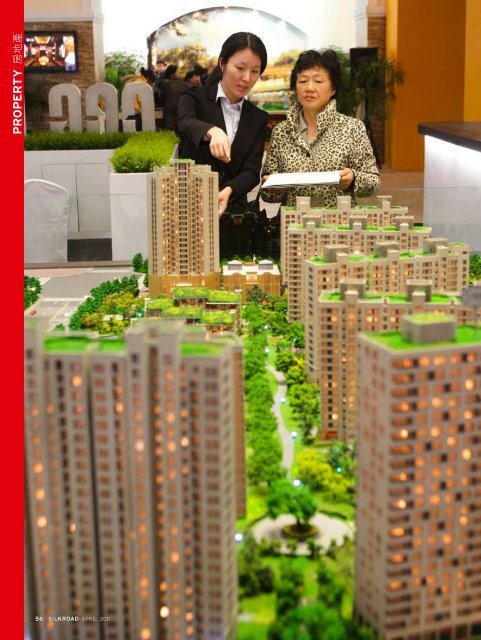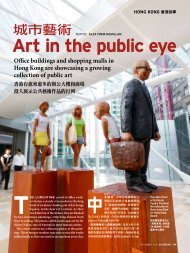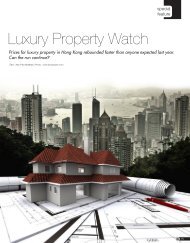P ro PE r TY - Dragonfly Media
P ro PE r TY - Dragonfly Media
P ro PE r TY - Dragonfly Media
You also want an ePaper? Increase the reach of your titles
YUMPU automatically turns print PDFs into web optimized ePapers that Google loves.
PRO<strong>PE</strong>R<strong>TY</strong> 房 地 產56 silk<strong>ro</strong>ad April 2011
PRO<strong>PE</strong>R<strong>TY</strong> 房 地 產mainland p<strong>ro</strong>perty tracker Holdways. Five cities saw theirprices climb more than 20 percent, with big gains also inGuangzhou (up 26.5 percent), Hangzhou (24.9 percent),Wuhan (24.4 percent) and Shanghai (21.8 percent).To combat such rapid rises, China’s State Council hasraised the minimum down payment on second homes to60 percent, up f<strong>ro</strong>m 50 percent. In late January, Shanghaiand Chongqing became the first cities to impose ap<strong>ro</strong>perty tax. Chongqing will tax homes bought at morethan twice the average price, with a maximum tax of1.2 percent for homes four times the average. Shanghai’slevy will be 0.6 percent of the value of second homes,and any home bought by a non-resident. The rate is cutto 0.4 percent for p<strong>ro</strong>perties with a transaction valuethat is less than twice the average home price.Even so, investors may do well to target smaller cities,where price gains have not been as rapid. The b<strong>ro</strong>kerageDTZ forecasts that new-home prices will rise 5 percent inmajor cities, while other cities will see 8 percent g<strong>ro</strong>wth.Cities such as Shanghai, Chengdu and Changsha havelittle new supply of homes coming on the market.DTZ says new construction has surged 35 percentcompared to a year ago, as local governments take stepsto deal with delayed construction sites, even seizingpossession of idle land. New-home sales will jump 15percent in major cities and 25 percent in other citiesthis year, it predicts.Last year, the central government also raised the minimumdown payment for first-time buyers to 30 percentof a home’s value, f<strong>ro</strong>m 20 percent. Banks were told tosuspend mortgages on third homes or more.A price of a home in central Shanghai now averagesabout RMB5.2 million (about HK$6.17 million), accordingto data f<strong>ro</strong>m Knight Frank, with an average price ofRMB39,301 a square metre – by far the highest in thecountry. Beijing is next, at RMB29,349 a square metre,giving an average home price of RMB3 million. Priced bythe square metre, next comes Hangzhou (RMB 23,874)then Guangzhou (RMB23,733) followed by Shenzhen(RMB18,681).Michael Cole, Research Director for East China atColliers International, says prices will continue to climbafter a period of adjustment to the new rules. Transactionvolumes will see “marked reductions” in the first half ofthe year, he predicts. Prices should be steady, with themarket starting to move ahead again late in the year.為 了 壓 抑 樓 價 的 升 勢 , 國 務 院 將 購 買 第 二套 住 房 的 首 期 付 款 , 由 五 成 上 調 至 六 成 。 今 年1 月 底 , 上 海 和 重 慶 成 為 內 地 首 批 實 施 房 產 稅的 城 市 。 重 慶 市 向 樓 價 高 出 平 均 價 兩 倍 以 上的 住 房 徵 收 房 產 稅 , 如 果 樓 價 高 出 平 均 價 四倍 將 最 多 徵 稅 1.2%。 上 海 則 向 第 二 套 房 徵 收樓 價 0.6% 的 房 產 稅 , 非 當 地 居 民 購 買 物 業 也納 入 徵 稅 對 象 。 若 成 交 價 不 高 於 平 均 價 兩 倍 ,徵 稅 降 至 0.4%。儘 管 如 此 , 投 資 者 可 考 慮 把 目 標 放 在 樓 價升 幅 相 對 落 後 的 較 小 城 市 , 以 爭 取 較 佳 回 報 。房 地 產 諮 詢 公 司 戴 德 梁 行 預 測 , 主 要 城 市 的新 建 住 宅 物 業 將 有 5% 升 幅 , 其 他 城 市 的 升 幅則 達 8%。 此 外 , 上 海 、 成 都 和 長 沙 等 城 市 的 新建 房 屋 供 應 量 不 多 。戴 德 梁 行 表 示 , 由 於 地 方 政 府 採 取 措 施 規管 沒 有 按 時 動 工 的 土 地 , 甚 至 是 充 公 閒 置 的住 宅 用 地 , 新 動 工 房 屋 較 一 年 前 急 增 三 成 五 ,因 此 主 要 大 城 市 今 年 的 新 房 銷 量 預 計 將 上 升一 成 五 , 其 他 城 市 則 上 升 二 成 五 。此 外 , 中 央 政 府 於 去 年 將 購 買 首 套 住 房 的首 期 付 款 , 由 樓 價 兩 成 提 高 到 三 成 。 銀 行 亦 停止 批 出 第 三 套 房 的 按 揭 貸 款 。根 據 萊 坊 的 統 計 , 上 海 市 中 心 區 的 住 房價 格 平 均 為 520 萬 人 民 幣 , 相 當 於 每 平 方 米39,301 人 民 幣 , 是 目 前 全 國 樓 價 最 高 的 城 市 。北 京 則 以 每 平 方 米 29,349 人 民 幣 的 價 格 排 在第 二 , 住 宅 物 業 的 平 均 價 為 300 萬 人 民 幣 。 以每 平 方 米 價 格 來 計 算 , 杭 州 以 23,874 人 民 幣緊 隨 其 後 , 接 著 是 廣 州 的 23,733 人 民 幣 , 以 及深 圳 的 18,681 人 民 幣 。高 力 國 際 華 東 地 區 研 究 部 總 監 MichaelCole 指 出 , 新 政 策 出 台 引 發 的 調 整 期 過 後 ,內 地 物 業 價 格 將 持 續 上 升 。 他 估 計 , 今 年 上 半年 的 成 交 量 將 顯 著 減 少 , 但 價 格 會 保 持 平 穩 ,而 市 場 會 在 下 半 年 再 度 升 溫 。P<strong>ro</strong>perty choice is widein Beijing with low- andmedium-density housingon offer (above)北 京 的 中 低 密 度 住 宅 選 擇 眾 多( 上 圖 )Displays such as RealEstate Guangzhou haveboosted purchases(above left)廣 州 房 地 產 交 易 博 覽 會 等 展 銷 會促 進 房 地 產 交 易 ( 左 上 圖 )Photos. Shanghai: Scott E Barbour – The Image Bank/Getty Images. Guangzhou: Xinhau News Photo. Beijing housing & Hangzhou: ChinaFotoPress58 silk<strong>ro</strong>ad April 2011
hina 2011 Trend Report中 國 風 尚 情 報FigurE ouT ThE housing dEMand 住 房 需 求Photos. Beijing construction: Nelson Ching – Bloomberg via Getty ImagesThe total population of Chinais not expected to g<strong>ro</strong>w in thenext decade, but the absolutenumber of households is expectedto increase as a result of a decliningnumber of persons per home.In 2010, China had an estimated433.2 million households and thisis p<strong>ro</strong>jected to reach 452.4 millionin 2020, an additional 1.9 millionhouseholds each year. This is arelatively small increase but themac<strong>ro</strong> picture ignores the significantchanges taking place in the structureof the society and households and theimplications of that for the demandfor housing.Two key underlying trends aretaking place, one fairly minor inimpact and one very significant.The minor trend is the rural-urbanshift of the population. This willcontinue but at a much slower paceas the rural areas have been hollowedout in terms of people aged 15 to 39,the g<strong>ro</strong>up that is willing and able tomove f<strong>ro</strong>m rural to urban areas on apermanent basis.As a result, the number of urbanhouseholds is p<strong>ro</strong>jected to increasef<strong>ro</strong>m 225.5 million in 2010 to 261.6million in 2020. This represents anannual g<strong>ro</strong>wth rate of 3.6 millionhouseholds, or 1.5 percent, a year.The more significant impact willcome f<strong>ro</strong>m the g<strong>ro</strong>wth of particularincome segments who can afforda better class of p<strong>ro</strong>perty and arelooking to spend money on housing.Two important income g<strong>ro</strong>ups areinvolved: those earning betweenRMB98,000 and RMB328,000 a year –6 percent of all urban households; andthose with an income of more thanRMB328,000, who represented 0.1percent of urban households in 2010.Both these segments are expectedto show considerable g<strong>ro</strong>wth in thenext decade. The RMB98,000 toRMB328,000 segment is expectedShanghai was one of five cities inChina with p<strong>ro</strong>perty price riseshigher than 20 percent in 2010上 海 是 2010 年 樓 價 升 幅 超 逾兩 成 的 五 個 內 地 城 市 之 一to add 6.2 million households ayear, each year, for the next 10 years.The RMB328,000-plus segment isp<strong>ro</strong>jected to add 303,900 householdsa year in the same period.At present, the supply side ofthe market has focused on theRMB328,000-plus segment andis creating a surplus relative tomedium-term demand levels. Thelower-income segment, which has thevolume potential, is perhaps beingunder-served because of the lowerp<strong>ro</strong>fit margins it offers. However, thatin turn could push up prices faster.Another important factor is that theg<strong>ro</strong>wth segment – urban householdswith an income of more thanRMB98,000 – is very concentrated interms of location with 50 percent ofthe new households in this incomesegment in just 117 of the 700 majorurban areas (urban areas with morethan 200,000 residents).– Global Demographics中國 總 人 口 預 計 在 未 來 十 年 內 不 會 有顯 著 增 長 , 但 隨 著 每 個 家 庭 的 人 數減 少 , 家 庭 數 將 會 出 現 上 升 。在 2010 年 , 中 國 約 有 4.332 億 戶 家 庭 ,預 計 到 了 2020 年 , 會 上 升 至 4.524 億 戶 家庭 , 相 等 於 每 年 增 加 190 萬 戶 家 庭 。 增 幅雖 然 並 不 顯 著 , 但 這 個 宏 觀 數 據 沒 有 反 映社 會 結 構 出 現 的 巨 大 改 變 , 以 及 這 些 改 變 對住 房 需 求 帶 來 的 影 響 。有 兩 個 主 要 的 趨 勢 正 影 響 著 未 來 發 展 ,其 中 一 個 影 響 較 輕 微 , 另 一 個 影 響 較深 遠 。人 口 由 鄉 鎮 向 城 市 轉 移 的 趨 勢 影 響 較 輕 。此 趨 勢 會 持 續 下 去 , 但 速 度 會 放 慢 , 因 為鄉 村 人 口 中 的 15 至 39 歲 群 組 , 最 有 意 欲及 能 力 到 城 市 定 居 , 但 他 們 許 多 早 已 離 開鄉 鎮 。因 此 , 城 市 家 庭 戶 數 預 計 由 2010 年 的2.255 億 戶 , 增 長 到 2020 年 的 2.616 億 戶 ,相 當 於 每 年 增 長 360 萬 戶 , 或 1.5%。而 帶 來 更 大 影 響 的 , 是 個 別 收 入 階 層 的 增長 。 這 些 階 層 的 人 可 負 擔 更 優 質 的 住 房 , 並願 意 投 入 更 多 金 錢 到 物 業 市 場 。這 當 中 包 括 兩 個 主 要 的 收 入 階 層 , 分 別 是年 收 入 介 於 98,000 人 民 幣 至 328,000 人民 幣 , 以 及 超 過 328,000 人 民 幣 的 家 庭 ; 在2010 年 , 前 者 約 佔 城 市 家 庭 數 的 6%, 後 者約 佔 0.1%。這 兩 個 收 入 階 層 的 數 目 預 料 在 未 來 十 年 有可 觀 的 增 長 。 收 入 介 於 98,000 至 328,000人 民 幣 的 家 庭 , 估 計 每 年 將 增 加 620 萬 戶 。 收入 超 過 328,000 人 民 幣 的 家 庭 則 預 計 每 年 增加 30.39 萬 戶 。目 前 市 場 的 供 應 主 要 針 對 收 入 超 過328,000 人 民 幣 的 家 庭 , 供 應 量 過 剩 , 足 以滿 足 中 期 需 求 。 然 而 , 收 入 較 低 階 層 對 住 房的 需 求 , 卻 因 為 邊 際 利 潤 較 低 而 被 發 展 商 忽視 。 不 過 , 這 卻 有 可 能 導 致 樓 價 因 供 應 短 缺而 急 升 。此 外 , 收 入 超 過 98,000 人 民 幣 的 城 市 家庭 這 一 高 增 長 階 層 的 分 佈 相 當 集 中 , 成 為另 一 個 影 響 物 業 市 場 的 重 要 因 素 。 全 國 擁有 20 萬 或 以 上 居 民 的 城 鎮 有 700 個 , 其 中117 個 城 鎮 便 居 住 了 這 個 收 入 階 層 五 成 的家 庭 。– Global DemographicsApril 2011 silk<strong>ro</strong>ad 59







